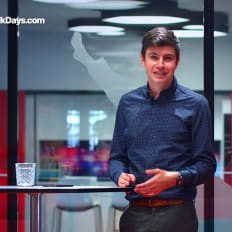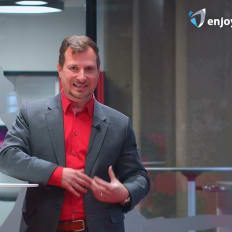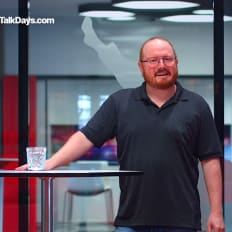
enjoy IT GmbH
Thomas Hintersteiner, Software Architect bei enjoy IT
Description
Thomas Hintersteiner von enjoy IT erzählt im Interview über seinen Weg – angefangen von der HTL bis hin zu seiner aktuellen Arbeit – und gibt Tipps für Personen die selbst mit dem Programmieren anfangen möchten.
By playing the video, you agree to data transfer to YouTube and acknowledge the privacy policy.
Video Summary
In "Thomas Hintersteiner, Software Architect bei enjoy IT," Thomas Hintersteiner traces his path from a technical high school to the web’s visually rewarding projects, then into studies and hands-on practice. At enjoy IT he designs solutions that bridge customers’ existing systems to their targets, handling integration, data processing, security, and getting people on board. His advice: start playfully (e.g., Lego robots and simple games), keep enjoyment and interest central, and progress from developer to architect by gaining experience across diverse systems—regardless of whether you come via HTL, university, or apprenticeship.
From Backend Skeptic to Web-Facing Architect: What we learned from “Thomas Hintersteiner, Software Architect bei enjoy IT” (enjoy IT GmbH)
The beginning wasn’t picture-perfect—and that’s exactly why it matters
Listening to “Thomas Hintersteiner, Software Architect bei enjoy IT,” we at DevJobs.at heard a developer journey that many in our community quietly recognize: the spark doesn’t always ignite at the first compile. Thomas Hintersteiner started at an EDV-HTL, where the initial focus was backend programming. His candid reflection: that didn’t immediately feel like the thing that would capture him—there was nothing visual to hold on to.
At the start, mostly backend programming—no visual feedback. It didn’t seem like what would interest me.
Then came the turning point: the internet grew, became accessible, and suddenly very exciting. With relatively simple means, he could build websites in different languages—and reach a large audience with little effort. That direct line from creation to visible impact flipped a switch.
The exciting part was reaching a large audience with little effort.
That move from “no visual feedback” to the immediacy of a web page is more than a personal anecdote. It’s a reminder of how motivation thrives on feedback: visibility, impact, and response—the trifecta that shaped Thomas’s path.
From classroom to practice—where things “really got exciting”
His journey continued from school to university and into real-world practice—“and there it actually got really exciting,” as Thomas put it. Without embellishment, that observation carries two patterns we see often:
- Practice amplifies relevance: with real systems, real users, and real requirements, priorities and learning deepen.
- Ambiguity beats the textbook: decisions that shape an architect emerge when theory meets constraints.
Thomas keeps the storytelling pragmatic: not a celebration of tools, but a focus on the context where technology must work. That lens leads to his role today.
The architect’s arc at enjoy IT GmbH: bridging what exists to what’s needed
In his role as a software architect at enjoy IT GmbH, work typically starts with a familiar tension: customers come with requirements. There is a target picture (how should it look?) and a starting point (what already exists?). The task is to craft a solution from what’s there and connect it to the goal so that the frontend displays what it should.
We have a goal—what should it look like—and a starting point—what is already there? As an architect, you think up a solution based on the existing and link it to the goal.
Thomas points to three recurring challenges within that bridge:
1) System integration: How do you integrate the customer’s systems so the frontend ultimately shows the intended result? Reality is rarely greenfield; it’s a mosaic of interfaces, data sources, legacy components, and evolving requirements.
2) Data processing: Data must be processed, transformed, and combined so the frontend doesn’t just show something—it shows the right thing, in the right context, at the right time.
3) Security: Not everyone should have access to backend systems. That’s a deceptively simple statement that carries authentication, authorization, and the balance of protection with user experience.
He also reminds us that the architect’s work is varied—technically and socially. Technology alone doesn’t build resilient solutions.
Beyond the technical part, it’s important to have people on board and integrate them well.
In other words: architecture is also alignment. Connecting people, teams, and stakeholders so technical decisions are understood and supported—and can have real impact.
Why visual feedback motivates—and what that means for learning
The early “visual gap” in his training and the later excitement for the web are more than timeline details. They show how much motivation thrives on tangible results. In Thomas’s words, building websites with relatively simple tools and reaching many people—that’s what clicked.
Here’s how we translate that into practical learning guidance:
- Make feedback visible early: learning sticks when you can feel progress, not just compile it.
- Projects over isolated drills: a small frontend that renders real data beats an abstract exercise.
- Reach as motivation: knowing that something will be seen and used builds energy, especially at the start.
Thomas’s concrete advice for beginners underlines the same idea.
Getting started today: playful, accessible, curious
For kids (or beginners) who want to start programming today, Thomas notes a variety of ways in: programmable Lego robots, simple games—tools that let you approach the craft step by step.
There are many options today: Lego robots, simple games—great for easing in.
For those a bit older, his compass is equally clear: have fun with what you do. Joy isn’t extra—it’s the foundation for sustained learning and persistence.
The most important thing is to have fun doing it. Spark interest through fun—that carries you.
He also frames the architect role as an organic progression from development: you start as a developer, see different systems, and then you begin to design solutions. Whether your path runs through a HTL, a university degree, or an apprenticeship is secondary.
Whether HTL, university, or apprenticeship—doesn’t matter. What matters is interest and having joy in what you do.
That posture takes the pressure off: there is no single golden education path. There is curiosity, exposure, and the willingness to own the design of solutions.
Turning requirements into solutions: a working guide from Thomas’s practice lens
What can we take from Thomas’s description into our own day-to-day architecture? From his concise yet pointed view, we draw a practical guide:
1) Sharpen starting point and target picture
- What exists? Systems, data, interfaces, processes.
- What should the outcome be? Not just UI—also behaviors and data flows.
- What gap must be bridged? Technically, functionally, organizationally.
2) Integration before perfection
- Integrating existing systems is rarely “clean from zero.” Accept reality.
- Define the minimal, reliable integration that delivers the intended frontend outcome.
- Optimize iteratively; first, make it visible and correct.
3) Treat data as a first-class concern
- Data processing is core, not an afterthought.
- Clarify what data moves where, when, and how transformations occur.
- Use the frontend as the test: is the right thing arriving in the right shape and time?
4) Security by default
- Not everyone should access backend systems—that’s policy, not a footnote.
- Design access so that protection and user experience are both respected.
- Think in roles and boundaries: who can do what, where, and when?
5) Bring people with you
- Architectural decisions live or die with buy-in.
- Explain the target picture in language and visuals everyone can follow.
- Bring teams into the process early; integration is social as much as technical.
The invisible work: managing expectations and making complexity legible
Between “starting point” and “target picture” lies a lot of invisible work: aligning expectations, clarifying terms, naming risks. Thomas doesn’t dwell on it, but his keywords—integration, data, security, people—hint at the breadth of the role. We see three recurring communication tasks beneath them:
- Translation: turn business goals into technical steps—and back again.
- Prioritization: what must be solved first to make the intended frontend result visible?
- Boundaries: what currently prevents that result from being achieved safely and reliably?
Take these seriously and complexity becomes navigable—teams avoid getting stuck on invisible blockers.
Motivation as a long-game factor: joy that sustains
Thomas’s emphasis on fun isn’t a casual aside—it’s a serious pointer for long careers. Motivation isn’t measured in certificates; it’s measured in energy for the next iteration. His personal inflection point—moving to more visible outcomes—shows why it pays to engineer for feedback.
Practically, that means:
- Build early, visible increments.
- Encourage low-risk, high-learning experiments (e.g., simple prototypes).
- Use tools that give quick feedback—whether Lego robots or a small web app.
Growing into the architect role: a pattern that works
Thomas frames architecture as a natural continuation of development: you start by building, you encounter different systems, then you begin to design the connections. Generalizing that yields a pattern:
- Breadth before deep specialization (at first): see different systems, understand strengths and constraints.
- From building blocks to blueprints: don’t just craft components—shape the connections.
- Own the responsibility: make decisions that span teams and concerns—technical and organizational.
From that follows a simple path: if you want to grow into architecture, seek out situations where integration, data flows, and security matter—and bring people with you.
Concrete action prompts—distilled from Thomas’s points
To make the bridge to practice explicit, here’s a set of prompts that flow directly from the session’s themes:
- Frame the outcome as a “frontend result.” Ask: what should be visible and usable?
- Diagram what exists: systems, data sources, permissions, interfaces.
- Define the first integrated path—from one source to one visible element—correct, secure, explainable.
- Put security before shortcuts: who can do what, and how is that enforced?
- Organize the earliest possible demo to surface feedback.
- Explain the solution in a way both engineers and business stakeholders can follow.
- Protect motivation: prefer tasks that deliver tangible results and encourage joy in the craft.
What this means across career stages
- Beginners: choose learning tools with fast feedback—Lego robots, simple games, small web projects. The quicker you see impact, the easier it is to stick with it.
- Junior to mid-level devs: look beyond component boundaries. How does data flow? What systems are involved? Where are the security fences?
- On the path to architecture: own the bridge from what exists to what’s needed. Start from reality and define the minimal, durable route to the target picture.
- Regardless of education path: HTL, university, or apprenticeship—pick what fits. Interest and joy are the true levers.
A grounded view of architecture
What makes the session valuable is its grounded tone. No hero narrative—just a clear description of what matters: identifying starting points, clarifying target outcomes, enabling integration, processing data, treating security as essential—and bringing people along. In that brevity lies precision.
For us, it’s a reminder that architecture is less about exotic patterns and more about designing transitions—from what exists to what’s genuinely needed.
Conclusion: Architecture begins where impact becomes visible
“Thomas Hintersteiner, Software Architect bei enjoy IT” underscores three durable truths: motivation grows when outcomes are visible; careers grow when you own the bridge from starting point to target; and sustainable solutions grow where security and empathy carry the same weight as technology.
- Build visible outcomes early.
- Respect what already exists—and design the path to the target picture.
- Think data and security from the start.
- Bring people along for the ride.
- Keep joy in the loop—it’s the long lever for quality and endurance.
Taken together, Thomas Hintersteiner’s story offers a crisp compass for developers aiming to grow into architecture: begin with reality, define what must become visible, and design the bridge—technically solid and socially durable. The rest is iteration.
More Dev Stories

enjoy IT GmbH Julian Deleja-Hotko, Software Developer bei enjoy IT
Julian Deleja-Hotko von enjoy IT redet im Interview über seine Anfänge mit dem Programmieren, was er in seiner aktuellen Arbeit macht und was seiner Meinung nach für Neueinsteiger wichtig ist.
Watch now
enjoy IT GmbH Stefan Weinzettel, Bid Manager bei enjoy IT
Stefan Weinzettel von enjoy IT berichtet im Interview über seinen Weg in das Bid Management, wie er in seiner Rolle im Unternehmen mit Developern zusammenarbeitet und gibt Tipps für Einsteiger.
Watch now
enjoy IT GmbH Thomas Hochgatterer, Back End Developer bei enjoy IT
Thomas Hochgatterer von enjoy IT gibt im Interview Einblicke in seinen Werdegang mit dem Prorammieren, wie sich sein Arbeitsalltag als Back End Developer gestaltet und gibt Tipps für Neueinsteiger.
Watch now
enjoy IT GmbH Joachim Waldl, Front End Developer bei enjoy IT
Joachim Waldl von enjoy IT gibt im Interview einen Einblick in seinen Werdegang zum Programmieren, einen Überblick in seine aktuelle Arbeit im Front End Development und schließlich Tipps für Beginner.
Watch now
enjoy IT GmbH Christof Amtmann, Project Manager bei enjoy IT
Christof Amtmann von enjoy IT spricht im Interview darüber, wie er über Umwege zum Project Management gekommen ist, was seine aktuelle Arbeit umfasst und gibt Tipps für Neueinsteiger.
Watch now
enjoy IT GmbH Oktay Akgül, Lead Developer bei enjoy IT
Oktay Akgül von enjoy IT erzählt im Interview wie er zum Programmieren gekommen ist, wie sich dann der Weg bis zu aktuellen Arbeit als Lead Developer gestaltet hat und gibt Tipps für Neueinsteiger.
Watch now






